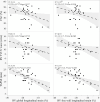Right ventricle free wall longitudinal strain screening of lung transplant candidates
- PMID: 39705303
- PMCID: PMC11661623
- DOI: 10.1371/journal.pone.0314235
Right ventricle free wall longitudinal strain screening of lung transplant candidates
Abstract
Background: Lung transplant (LUTX) candidates have subclinical right ventricular (RV) dysfunction, which has not yet been assessed by speckle-tracking echocardiography (STE)-derived RV free-wall longitudinal strain (RVFWLS). To evaluate the prevalence of RV dysfunction by RVFWLS and its relationship with conventional RV echocardiographic indexes in LUTX candidates.
Methods: In a single-center prospective observational cohort study, from January 2021 to March 2023 consecutive LUTX candidates underwent cardiac catheterization, radionuclide ventriculography, standard and STE. The diagnostic accuracy of RV ejection fraction by ventriculography (RVEF), tricuspid annular plane excursion (TAPSE), fractional area change (FAC), tricuspid peak annulus systolic velocity (S') versus RVFWS were computed.
Results: Thirty-four patients (female, 41%) with a mean age of 48 [36-59] years old enlisted for pulmonary fibrosis (35%) and cystic fibrosis (30%) were included. At cardiac catheterization, only 7 (23%) had pulmonary hypertension. Around 15-25% presented right heart enlargement. Tricuspid regurgitation was present in 20 (60%) of the patients. Median RVFWLS was -20.1% [-22.5%--17%], being impaired (> -20%) in 16 (47%) of the patients. RVFWLS identified the highest percentage (47%) of RV dysfunction, compared to TAPSE (32%), S' (27%), FAC (26%), and ventriculography (15%), which had very low sensitivity for detecting RV dysfunction compared to RVFWLS.
Conclusions: In patients enlisted for LUTX, RV dysfunction assessed by STE-derived RVFWLS is highly prevalent. STE can detect RV dysfunction better than standard two-dimensional echocardiography and ventriculography. Further studies are urgently needed to define the clinical implications and the prognostic value of RV dysfunction measured with RVFWLS.
Copyright: © 2024 Scaravilli et al. This is an open access article distributed under the terms of the Creative Commons Attribution License, which permits unrestricted use, distribution, and reproduction in any medium, provided the original author and source are credited.
Conflict of interest statement
The Fondazione per la Ricerca sulla Fibrosi Cistica supported the study (# FFC 27/2019), and in particular the project was adopted by the Delegazione FFC di Napoli San Giuseppe Vesuviano and the Delegazione FFC di Como Dongo). The first author Dr. Vittorio Scaravilli received from the aforementioned grant support for publication and congress participation. Prof. Giacomo Grasselli received payment for lectures from Thermo-Fisher and Pfizer Pharmaceuticals and travel-accommodation-congress support from Biotest (all these relationships are unrelated with the present work). Moreover, this study was (partially) funded by Italian Ministry of Health – Current Research IRCCS. This does not alter our adherence to PLOS ONE policies on sharing data and materials.
Figures




References
-
- Weill D., Benden C., Corris PA., et al.. A consensus document for the selection of lung transplant candidates: 2014—an update from the Pulmonary Transplantation Council of the International Society for Heart and Lung Transplantation. J Heart Lung Transplant 2015;34(1):1–15. doi: 10.1016/j.healun.2014.06.014 - DOI - PubMed
Publication types
MeSH terms
LinkOut - more resources
Full Text Sources
Medical
Research Materials

